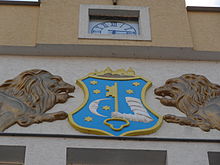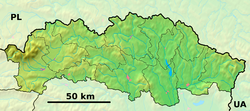Humenné | |
|---|---|
Town | |
From the top, Panoramic view of Humenné, Vihorlat Museum, Church of Archangel Michael | |
Location of Humenné in the Prešov Region | |
| Coordinates: 48°56′09″N 21°54′24″E / 48.93583°N 21.90667°E | |
| Country | |
| Region | Prešov |
| District | Humenné |
| Historical region | Zemplín |
| First mentioned | 1317 |
| Government | |
| • Mayor | Miloš Meričko |
| Area | |
| • Total | 28.63 km2 (11.05 sq mi) |
| (2022) | |
| Elevation | 155[2] m (509[2] ft) |
| Population | |
| • Total | 30,450 |
| • Density | 1,100/km2 (2,800/sq mi) |
| Time zone | UTC+1 (CET) |
| • Summer (DST) | UTC+2 (CEST) |
| Postal code | 066 01[2] |
| Area code | +421 57[2] |
| Car plate | HE |
| Website | www |
Humenné (ⓘ; Hungarian: Homonna; Ukrainian: Гуменне) is a town in the Prešov Region ("kraj") in eastern Slovakia and the second largest town of the historic Zemplín region. It lies at the volcanic Vihorlat mountains and at the confluence of the Laborec and Cirocha Rivers.
Names and etymology[edit]
The name comes from a common Slavic word "humno" (gumьno). In Slovak "backyard", the exact meaning may differ in dialects. Initially, a female adjective (1322 Homonna, 1332 Humenna, 1381 Humenna, 1391 Humonna) then neutrum Humenné.[4]
Landmarks[edit]
Humenné is a center of one of the easternmost districts ("okres") in Slovakia. The most attractive places are the Vihorlat Mountains boasting of their Morské oko lake, and the Bukovské vrchy (section of the Bieszczady Mountains) at the border of Slovakia, Poland, and Ukraine, which are part of the Poloniny National Park. Humenné is surrounded by ruins of medieval castles and an open-air museum of architecture situated in the town park.
Castles and mansions near Humenné:
- Brekov Castle (in ruins, 7 km (4 mi) to the southwest)
- Jasenov Castle (in ruins, 3 km (2 mi) to the south)
- Čičava Castle (in ruins, 14 km (9 mi) to the southwest )
- Kamenica nad Cirochou: Classicistic mansion from 1773 (at the moment closed for public, 7 km (4 mi) to the east)
History[edit]

The Laborec river and the Carpathian mountains predetermined the development of the town and its surroundings, a silent witness of which has been Vihorlat volcano, at 1,075 m (3,526.90 ft) the highest peak of the Vihorlat mountains. Thanks to its advantageous location and pleasant climate, preconditioned by the neighboring mountains, the town has been an attractive place for people since the Stone Age, which is evidenced by a number of archeological findings. The Slavic forefathers of the Slovaks gradually moved to the basin of Humenné during the great migration of peoples, starting in the 5th century.
An intensive and organized settlement of this area started as late as in the middle of the 13th century, after the Mongol raids. The first written document mentioning Humenné dates back to 1317. The history of Humenné is closely connected with the Drugeth (Drugets, Drugetovci), a distinguished aristocratic family originally from Naples, who, accompanying the king Charles Robert of Anjou, came to the Kingdom of Hungary (the territory of present-day Slovakia was part of the Kingdom of Hungary) at the beginning of the 14th century. The Drugeths made Humenné their seat and changed it into the centre of one of the largest feudal dominions in Upper-Hungary. King Matthias Corvinus conferred civic privileges (town status) on the town, which were validated by a seal with coat of arms. At that time, the town was crossed by an important trade route connecting the Kingdom of Hungary with the Kingdom of Poland. Humenné is mentioned among royal customs offices, and later on it received the right of storehousing and supposedly market rights, too. This was also the time of an ever-increasing influence of shepherd colonization from Transcarpathia by the so-called Walachians (Ruthenes, Poles, and Romanians).
The most significant town monument, a Renaissance castle, was built on the place of an original stone castle in about 1610. The castle came to be an indispensable characteristic feature of the town and serves for museum and cultural purposes at present.
In 1613, during the Counter Reformation, a Jesuit college was established as the first secondary school in the history of Humenné.
In 1619, about 10,000 Polish riders—a lisowczycy—led by Walenty Rogawski, defeated army of George I Rákóczi in Battle of Humenné. Rákóczi was insurgent against Habsburgs and ally of Gábor Bethlen, Duke of Transylvania.
The Drugeth line died out in 1684 and new feudal lords moved in, notably the Csákys and the Wandernats.
The abolition of some feudal duties and the reforms of Maria Theresa promoted the development of crafts, and Humenné became the seat of the so-called "salt office". The town's population consisted of Slovaks, Ruthenes, Hungarians and Jews. Latin was used as the administrative language, which appeared to be a stabilizing factor in such a mixture of nationalities.
The Andrássy family from Transylvania started to influence the history of Humenné in the 19th century, a period characterized by economic growth. Moreover, many new buildings were erected at that time. The main fields of activities of town inhabitants were agriculture, crafts and trade. The first train appeared in Humenné in 1871, stimulating the development of trade and wood cutting. In 1899 the first business academy in Austria-Hungary was established in Humenné. Toward the end of the 19th century, Humenné counted 4,000 inhabitants.
The 20th century brought along a cultural revival. Humenné was famous for its markets and fairs. This promising, though timid, development was interrupted by World War I. A short period of the existence of Czechoslovakia between the two world wars proved to have positive effects upon the life of Humenné. As a corollary of World War II, however, all the effort had to start from the very beginning. On 26 November 1944, Humenné was captured by troops of the Soviet 18th Army, acting as a part of the 4th Ukrainian Front, after which the town became again part of Czechoslovakia.

Until 1956 Humenné was an administrative rather than an economic centre. Then the construction of a plant for the production of textile polyamide fibres, the present Chemlon company, triggered a real chain effect on the town's growth. Humenné was gradually becoming a centre of chemical, building, food and mechanical engineering industries. This had a positive impact on the development of technical colleges. The industrial development entailed large-scale housing projects, and the town area was completed by new housing estates. While there were 7,000 inhabitants living in Humenné in 1948, the population now amounts over 33,000.
Demographics[edit]
According to the 2012 census, the town had 34,634 inhabitants. However, along with the surrounding villages that make up the town-ring, Humenné has some 42 thousand inhabitants. 79% of inhabitants were Slovaks, 6.5% Rusyns, 2.33% Roma, 1.16% Ukrainian and 0.49% Czechs.[5] The religious makeup was 57.91% Roman Catholics, 23.00% Greek Catholics, 8.69% people with no religious affiliation, 5.91% Orthodox and 0.98% Lutherans.[5]
In 1910, 48.6% were Roman Catholic, 34.8% Jewish, 12.3% Greek Catholic, while 38.2% reported Hungarian as their primary language, 30.8% Slovak and 21.1% Yiddish or German.
Sports[edit]
Football[edit]
Humenné had one club with top flight history: FC Chemlon Humenné, winning Slovak Cup in 1996. FC Chemlon also played UEFA Cup Winners' Cup in the 1996–97 season. The club had a more turbulent time during its name changes as; HFC Humenné, 1. HFC Humenné and ŠK Futura Humenné and could not replicate its success as Chemlon. In August 2015, the licence of ŠK Futura was bought by FK Drustav Svidník, but the Slovak Football Association rules do not allow to change club names only a few days before the start of the season. The Svidník club also announced a merger between FK Drustav and ŠK Futura within one year with a new name.[6]
FK Humenné is the second club in Humenné, established in 2003, playing home matches at the Ihrisko pri Mlyne Stadium, they currently play in the 4th division.
Volleyball[edit]
Humenné had one of the most successful team VK Chemes Humenné in Slovak volleyball but due to dispute between owner and town about finance, club was transferred to another town Spišká Nová Ves. Nowadays no one volleyball club is in Humenné.
Ice hockey[edit]
The city's ice hockey club is MHK Humenné, that competes in Slovak 1.Liga (2nd level).
Largest companies in Humenné (2015)[edit]
- Andritz Slovakia
- Nexis Fibers
- Reinter
Notable natives and residents[edit]

- Štefan Babjak (1931-2008), opera singer
- Peter Breiner (born 1957), pianist, conductor, and composer
- Marian Čekovský, Artist
- Yuri Dojc (born 1946), Artist and Photographer
- Ladislav Grosman (1921-1981), Oscar prize winner
- František Kasanič (born 1976), professional boxer
- Michal Kováč (1930-2016)- first Slovak president in the modern era
- Gabriel A. Levicky, Artist[7]
- Morris Newfield (1869-1940), rabbi
- Erik Tomáš (born 1975), politician
- István Thomán (1862-1940) Hungarian piano virtuoso and music educator
- Jozef Tomko (1924-2022), cardinal
- Ágoston Trefort (1817-1888), Hungarian politician, who served as Minister of Religion and Education from 1872 until his death. He was the President of the Hungarian Academy of Sciences from 1885
- Joachim Jacob Unger (1826-1912), rabbi
- Ferenc Zichy, bishop
Twin towns – sister cities[edit]
See also[edit]
References[edit]
- ^ Statistical Office of the Slovak Republic (www.statistics.sk). "Hustota obyvateľstva - obce". www.statistics.sk. Retrieved 2024-02-08.
- ^ a b c d "Základná charakteristika". www.statistics.sk (in Slovak). Statistical Office of the Slovak Republic. 2015-04-17. Retrieved 2022-03-31.
- ^ Statistical Office of the Slovak Republic (www.statistics.sk). "Počet obyvateľov podľa pohlavia - obce (ročne)". www.statistics.sk. Retrieved 2024-02-08.
- ^ Uhlár, Vlado (1982). "Miestne názvy Humenné a Cimenná" (PDF). Slovenská reč (in Slovak) (6). Jazykovedný ústav Ľudovíta Štúra SAV: 357.
- ^ a b "Municipal Statistics". Statistical Office of the Slovak republic. Archived from the original on 2008-01-11. Retrieved 2008-01-12.
- ^ ŠK Futura priniesla pod Duklu vyššiu súťaž August 4, 2015
- ^ Gabriel, Levicky. "Gabriel Levicky (born Gabriel Levický), 1948". National Czech & Slovak Museum & Library. NCSML.
- ^ "Partnerské mestá" (in Slovak). Humenné. Retrieved 2019-09-03.
External links[edit]
 Media related to Humenné at Wikimedia Commons
Media related to Humenné at Wikimedia Commons- Page of the town Humenné
- UrbanPark - photo project about Humenné
- Childhood Dream - project about community life in Humenné





